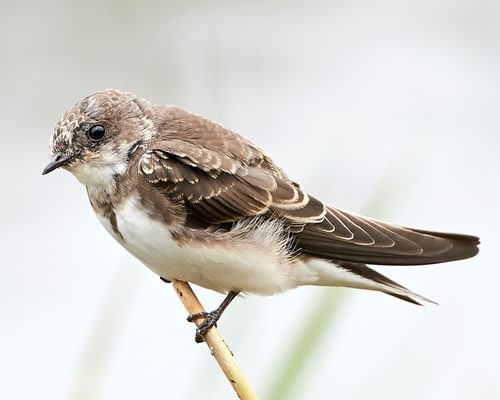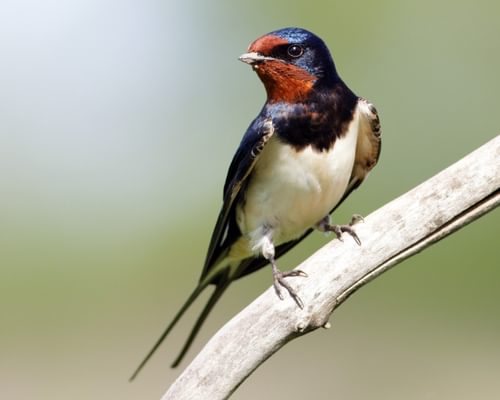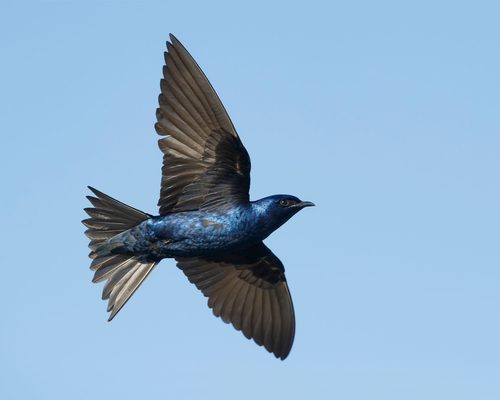House Martin
Least ConcernDelichon urbicum
Visual Identification
Appearance
The House Martin is a small, compact swallow with distinctive white underparts and rump contrasting with glossy blue-black upperparts. Its short, forked tail and white-feathered legs are key identifying features. The bird's head is flat, and its bill is short and black.
Both sexes look alike, with juveniles showing a duller plumage and a less pronounced fork in the tail. There are no significant seasonal plumage changes in this species.
Size
Length
13cm to 15cm
Wingspan
26cm to 29cm
Weight
15g to 23g
Colours
Males and females have similar plumage
Primary Colour
Blue White
Secondary Colour
Black
Beak Colour
Black
Leg Colour
Pink
Habitat and Distribution
Habitats
Woodland
Garden
Wetland
Coastal
Urban
Farmland
Grassland
Desert
Tundra
Rainforest
Mountain
Savanna
Distribution
House Martins are widely distributed across Europe, Asia, and parts of North Africa. They prefer open country near human settlements, including farmland, villages, and suburban areas. These birds are particularly common in the UK, where they are familiar summer visitors.
During winter, House Martins migrate to sub-Saharan Africa, with some populations travelling as far as South Africa. In spring, they return to their breeding grounds in Europe and Asia, typically arriving in April or May.
Elevation Range
Up to 2,000 meters
Climate zones
Temperate, Subtropical
Distribution Map
This map gives you a rough idea of where you might spot a House Martin. The coloured areas show countries where these birds have been seen.
A few things to keep in mind:
- Birds might not be everywhere in the coloured areas, for example, they may be present around the coast of that country
- Where birds live can change with seasons and available food
- This map is quite simple - it doesn't show exact locations
We're working on making our maps even better! Soon, we hope to show you:
- More detailed maps for bigger countries, including state and region
- How birds move around during different seasons
Distribution by Region
Behaviour and Ecology
Bird Attributes
This feature is in beta. We'd love your feedback to improve it!
Share your thoughtsBird Attributes Explained
Our bird attributes system rates various aspects of a bird's capabilities on a scale of 0-100, based on data from field observations, scientific studies, and expert knowledge.
Attribute Categories:
- Agility: Manoeuvrability, speed, and grace in flight or movement.
- Strength: Physical power, often correlating with size and hunting abilities.
- Adaptability: Ability to thrive in various environments or changing conditions.
- Aggressiveness: Territorial behaviour and assertiveness, particularly during breeding seasons.
- Endurance: Stamina, often seen in migration patterns or foraging behaviours.
Understanding the Ratings:
- 0-20: Very Low
- 21-40: Low
- 41-60: Average
- 61-80: High
- 81-100: Very High
Remember, these attributes are relative to other bird species and don't necessarily indicate superiority.
Hover over the icon next to each attribute for more information.
Tap the icon next to each attribute for more information.
Agility
Reflects the bird's manoeuvrability, speed, and grace in flight or movement.
House Martins display exceptional agility, with their ability to perform swift, darting movements to catch insects mid-flight. Their graceful aerial acrobatics and capacity to fly at speeds up to 40 mph demonstrate remarkable manoeuvrability.
Strength
Indicates the bird's physical power, often correlating with size and hunting abilities.
Whilst not particularly strong compared to larger birds, House Martins possess sufficient strength to carry mud for nest-building and to migrate long distances. However, their small size limits their overall physical power.
Adaptability
Represents the bird's ability to thrive in various environments or changing conditions.
These birds show high adaptability, thriving in various habitats from farmland to urban areas. Their ability to construct nests on modern buildings and adjust their feeding height based on weather conditions indicates significant adaptiveness.
Aggressiveness
Measures the bird's territorial behaviour and assertiveness, particularly during breeding seasons.
House Martins are generally non-aggressive, preferring to live in social groups. They may defend their nests, but overall, their behaviour is characterised more by sociability than aggression.
Endurance
Reflects the bird's stamina, often seen in migration patterns or foraging behaviours.
The House Martin's endurance is impressive, evidenced by their long-distance migrations from Europe to sub-Saharan Africa. Their ability to fly continuously while feeding and their capacity to consume up to 3,000 insects daily also suggest considerable stamina.
Diet
House Martins are insectivores, primarily feeding on flying insects such as aphids, flies, and beetles. They catch their prey in mid-air, often at considerable heights.
During poor weather, these birds may feed closer to the ground, skimming low over water bodies to catch emerging insects. Occasionally, these birds will follow farmers' ploughs and livestock in search of the insects they disturb.
Behaviour
House Martins are highly social birds, often seen in large flocks during migration and when feeding. They exhibit graceful, agile flight, catching insects on the wing with swift, darting movements.
These birds frequently gather mud for nest-building, a behaviour often observed near puddles or pond edges.
Vocalisation
House Martins have a soft, pleasant twittering call, often described as a gentle 'prrit' or 'prrip'. In flight or around nesting sites, they produce a rapid series of these notes, creating a cheerful, chattering effect. During courtship, males may sing a more prolonged, warbling song.
Nesting & Breeding
House Martins form monogamous pairs and breed during the summer months in their northern range. They typically arrive at breeding sites in April or May. Males often return to previous nesting sites and may start building before females arrive.
Nests are constructed from mud pellets mixed with grass or feathers, forming a cup shape attached to the exterior of buildings, usually under eaves. The nest's interior is lined with feathers and fine grasses. Females lay 3-5 white eggs.
Both parents incubate the eggs for about 14-16 days. After hatching, nestlings are fed by both parents for approximately 22-32 days before fledging. In favourable conditions, pairs may raise two or even three broods in a season.
Lifespan
years
The House Martin typically lives for 5 to 8 years.
Like all birds, lifespan can be affected by factors including predation, habitat quality, disease, and access to food sources.
Conservation and Status
Global Conservation Status
While currently listed as Least Concern, House Martin populations have declined in parts of Europe. Factors include loss of nesting sites due to modern building practices and changes in insect abundance.
Conservation efforts focus on protecting existing colonies and promoting the use of artificial nest cups.
Birdwatching Tips
- Look for House Martins near buildings, especially those with overhanging eaves
- Observe their distinctive white rump in flight, which distinguishes them from swallows
- Listen for their soft, twittering calls, especially around nesting sites
- In the UK, watch for them from April to September during their breeding season
Additional Information
Quick Facts
Other names:
Common House Martin, Northern House Martin
Family:
HirundinidaePredators
House Martins face predation from birds of prey such as Sparrowhawks and Hobbies, as well as domestic cats when nesting near human habitations.
Did You Know?
- House Martins can fly at speeds of up to 40 mph when pursuing insects.
- A single House Martin can consume up to 3,000 insects per day.
- These birds have been known to reuse the same nest for multiple years, repairing and rebuilding as needed.
Was this bird profile helpful?
Your feedback helps us improve our content
Thanks for your feedback!
Your input helps us improve our content.
Community Experience
Community Ratings
No ratings yet - be the first to rate this bird!
Latest Community Reviews
No reviews yet
Sign in to be the first to review
Community Reviews
Create Your Free Account Welcome Back!
Join our community to rate birds and share your experiences. Creating an account is completely free and only takes a minute. Sign in to your account to rate birds and share your experiences with our community.
Your information is secure and will never be shared.
By creating an account, you agree to our Privacy Policy.
Similar Birds
References
- 1 2
website: BirdLife International. 2017. Delichon urbicum (amended version of 2016 assessment). The IUCN Red List of Threatened Species 2017: e.T103811886A118748864.
View source - 3
report, 2015: EBCC


